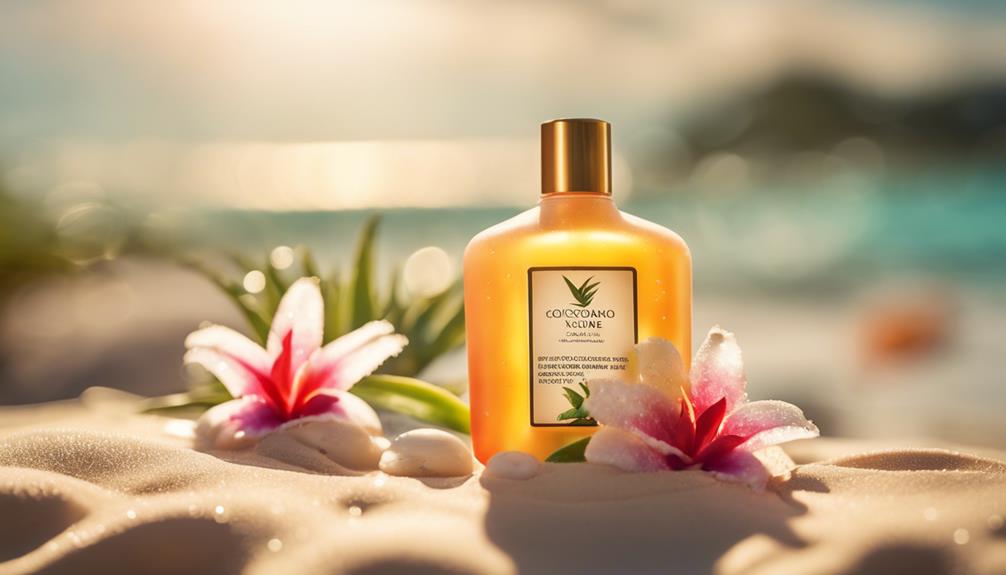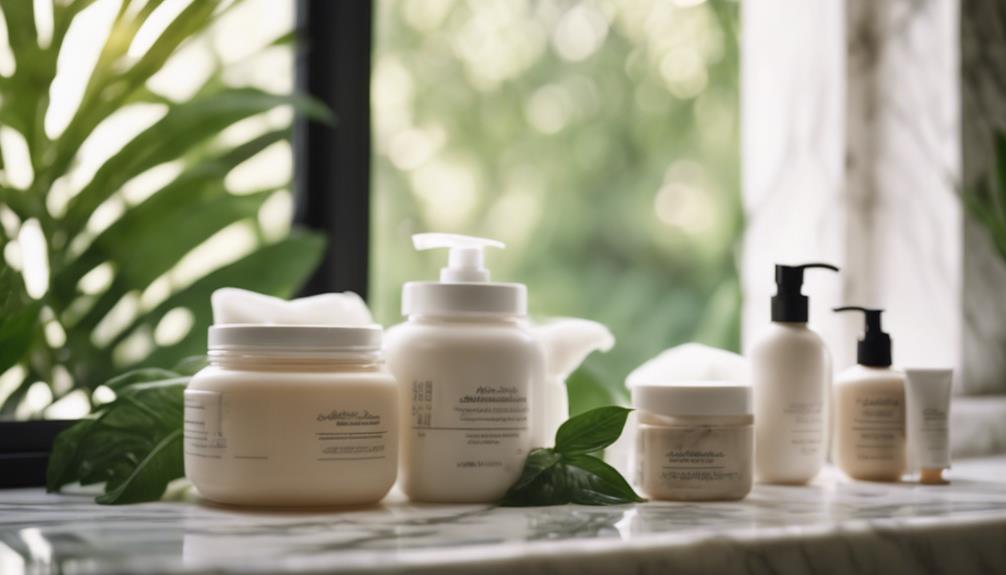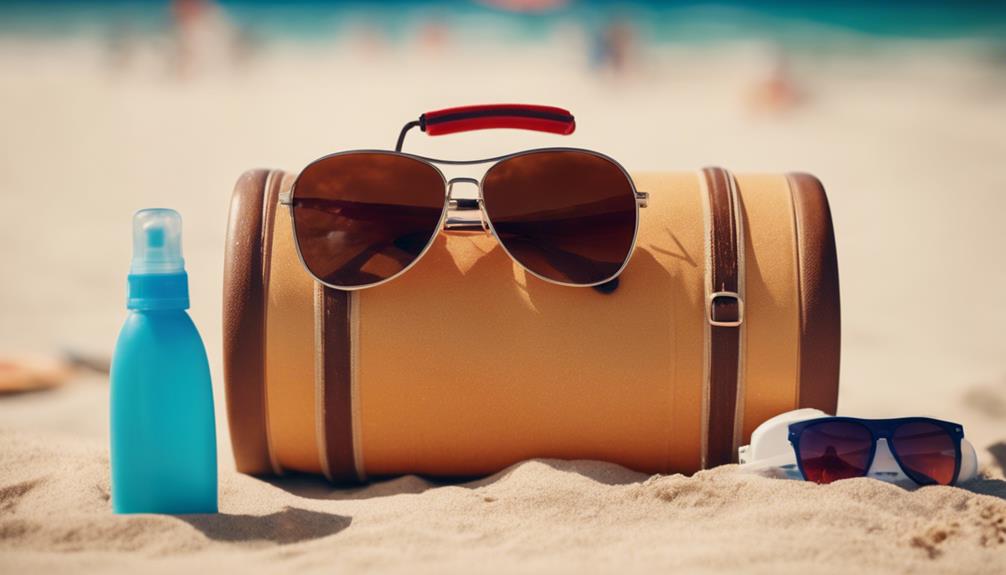To open radiant skin with after-tan lotion, you need to choose the right product. These lotions keep your skin hydrated and extend that sun-kissed glow. They seal in moisture, preventing dryness and enhancing elasticity. Look for key ingredients like aloe vera, vitamin E, and vitamin C for soothing and nourishing benefits. Apply generously, especially on dry areas, and wait at least eight hours post-tan for best absorption. Avoid hot showers and harsh soaps afterward. By selecting the right lotion and following these tips, you'll maintain your radiant complexion. There's a lot more to explore about keeping that glow alive!
Key Takeaways
- After-tan lotion hydrates skin, locking in moisture to enhance suppleness and radiance.
- Key ingredients like aloe vera and vitamins nourish and soothe, promoting a vibrant complexion.
- Regular application helps maintain the sun-kissed glow while providing protection against environmental damage.
- Avoid hot showers and harsh soaps post-tan to maximize the effectiveness of after-tan products.
Importance of After-Tan Lotion
After-tan lotion is essential for keeping your skin hydrated and radiant while helping to extend the life of your sun-kissed glow.
Using it regularly locks in moisture and feeds your skin crucial nutrients, promoting a flawless appearance. This lotion acts as a protective barrier against environmental damage, ensuring your tan lasts longer and looks even.
By incorporating after-tan lotion into your daily routine, you create a ritual that enhances your skin's radiance and health. You'll notice how your skin feels softer and more supple, giving you that coveted glow.
Prioritizing after-tan lotion isn't just about aesthetics; it's about maintaining your skin's vitality and ensuring it stays nourished and protected from harsh elements.
Benefits of Hydration for Skin
Hydration plays an essential role in maintaining your skin's health and appearance, preventing moisture loss and enhancing its natural barrier against environmental stressors. When you keep your skin hydrated, you're helping it stay plump and youthful while soothing irritation and redness. This consistent hydration promotes overall skin vibrancy, essential for a flawless tan.
| Benefit | Description |
|---|---|
| Prevents Dryness | Locks in moisture, keeping skin supple |
| Enhances Elasticity | Maintains skin's firmness and resilience |
| Reduces Redness | Calms irritation from sun exposure |
| Promotes Glow | Boosts skin radiance and vibrancy |
| Strengthens Barrier | Protects against environmental damage |
Key Ingredients in After-Tan Lotions

Key ingredients in after-tan lotions frequently include nourishing elements like aloe vera and antioxidant vitamins that work together to enhance your skin's health and appearance.
Aloe vera soothes and cools your skin, providing relief from any irritation caused by tanning.
Vitamin E acts as a protector, nurturing your skin and preventing further damage.
Meanwhile, Vitamin C brightens your complexion, giving it a fresh, luminous look.
Don't forget about Vitamin A; it helps maintain your skin's barrier, ensuring resilience against environmental stressors.
Together, these ingredients not only nourish and hydrate but also promote a healthier, more vibrant appearance.
Application Techniques and Common Mistakes
Applying after-tan lotion correctly can greatly enhance your tan's longevity and keep your skin looking its best.
First, wait at least eight hours post-tan before applying the lotion; this helps with ideal absorption.
When you do apply, use a generous amount and spread it evenly across your entire body, paying special attention to dry areas.
Make it a habit to apply regularly for improved hydration and to promote a smooth finish.
Avoid common mistakes like taking hot showers right after tanning, skipping the lotion, or using harsh soaps that can strip your skin.
Also, limit additional sun exposure and don't exfoliate excessively, as these can quickly fade your tan.
Your skin deserves the best care!
Selecting and Maintaining After-Tan Products

Choosing the right after-tan products is crucial for keeping your skin hydrated and your tan looking vibrant.
Look for luxurious hydrators like Tan-Luxe the Butter, which deeply nourishes your skin.
Don't overlook products with environmental shields, such as Hampton Sun SPF 50+, to protect your glow.
Sustainable options using organic ingredients, like Glimmer Goddess, are great too.
Buildable glow products, like Jergens Natural Glow Daily Moisturizer, help you maintain your tan effortlessly.
To keep your skin in top condition, apply these lotions regularly.
They not only enhance hydration but also shield your skin from damage.
Prioritizing high-quality after-tan products guarantees lasting radiance, boosts your skin health, and keeps your sun-kissed glow looking fresh and beautiful.
Frequently Asked Questions
Can After-Tan Lotion Be Used on All Skin Types?
Yes, after-tan lotion can be used on all skin types. It hydrates, soothes irritation, and enhances your tan's longevity, making it beneficial whether you have dry, oily, or sensitive skin. Just choose the right formulation for you.
How Often Should I Apply After-Tan Lotion?
Isn't it fascinating how a little care can extend your glow? You should apply after-tan lotion daily for the best results, keeping your skin hydrated and vibrant while enhancing the longevity of your gorgeous tan.
Is After-Tan Lotion Suitable for Sensitive Skin?
Yes, after-tan lotion can be suitable for sensitive skin, especially those formulated with gentle ingredients. Always check the label, and consider a patch test to guarantee it won't cause irritation or adverse reactions.
Can I Use After-Tan Lotion on My Face?
You can absolutely pamper your face with after-tan lotion! It hydrates and soothes, giving your complexion a nourishing treat. Just verify it's gentle enough for your skin type, and enjoy that radiant glow!
Does After-Tan Lotion Expire?
Yes, after-tan lotion can expire. Always check the expiration date on the packaging. If it smells off or has changed in texture, it's best to discard it to avoid skin irritation.
Conclusion
You might think your tan's the star of the show, but without after-tan lotion, it's like a beautiful sunset fading into darkness.
By skipping this essential step, you're tossing away the glow you worked so hard to achieve.
So, embrace the irony: your radiant skin depends on a humble lotion.
Make it a priority, and watch as your sun-kissed look transforms into a lasting confidence boost.
After all, why settle for temporary beauty when you can have it all?









